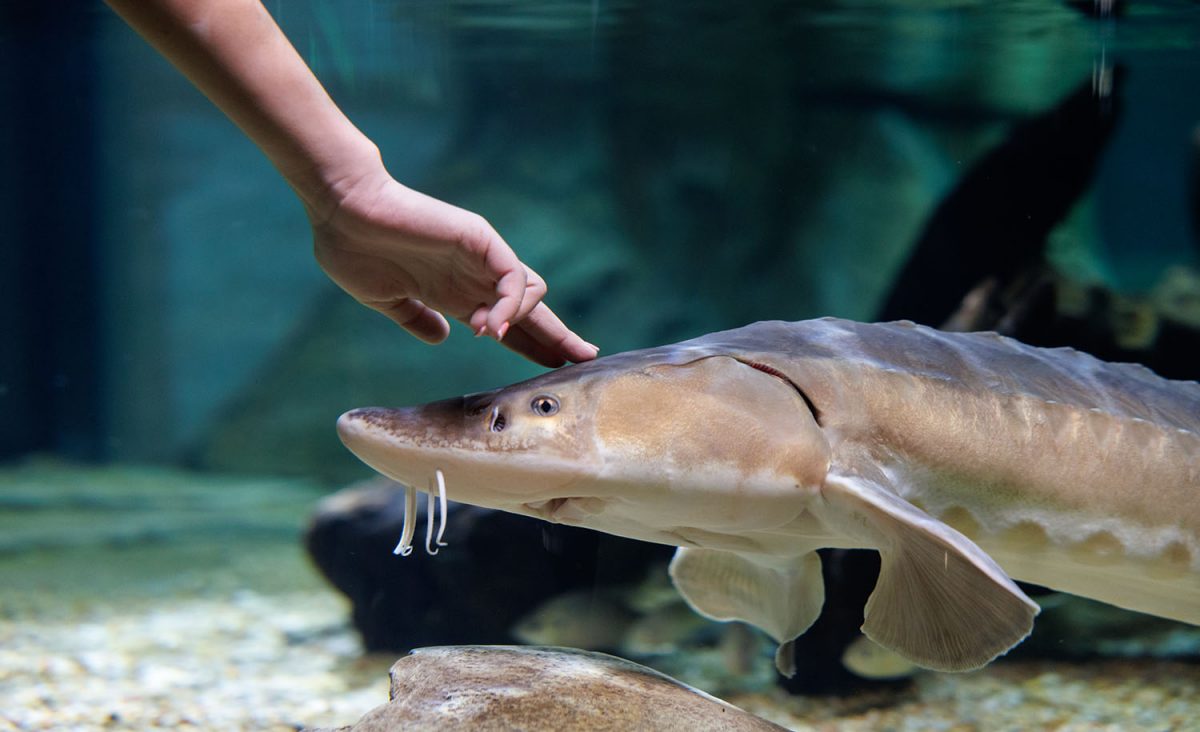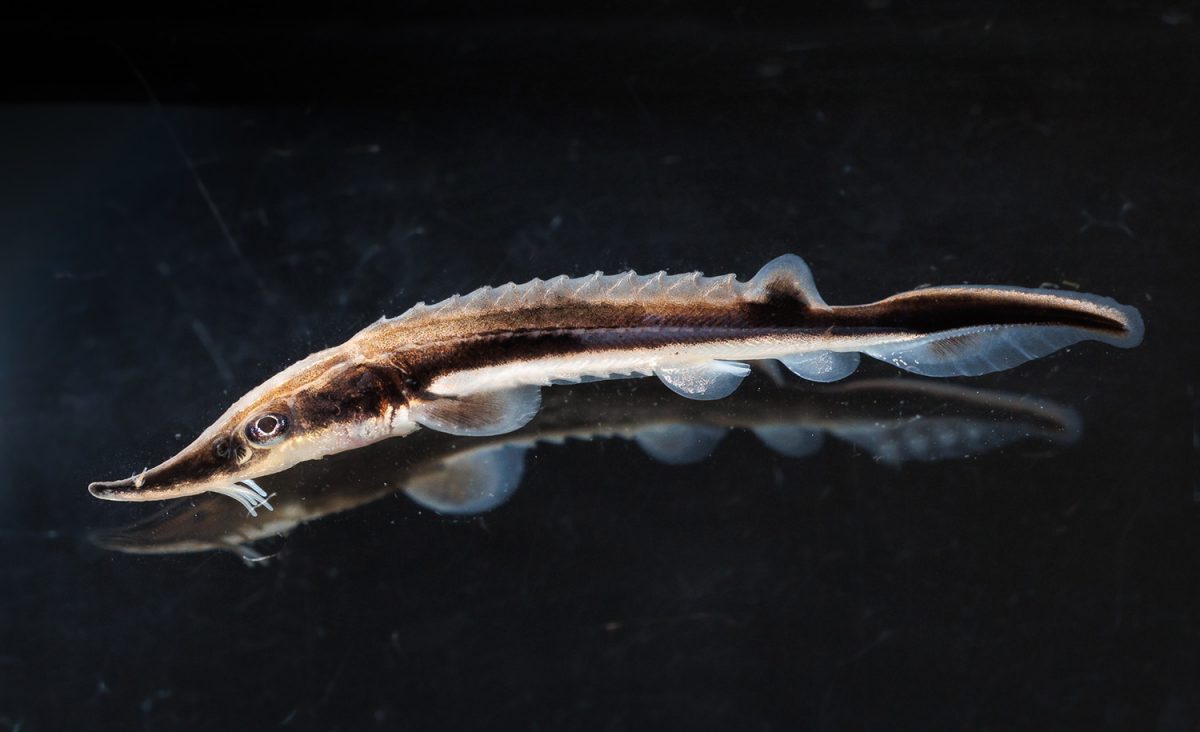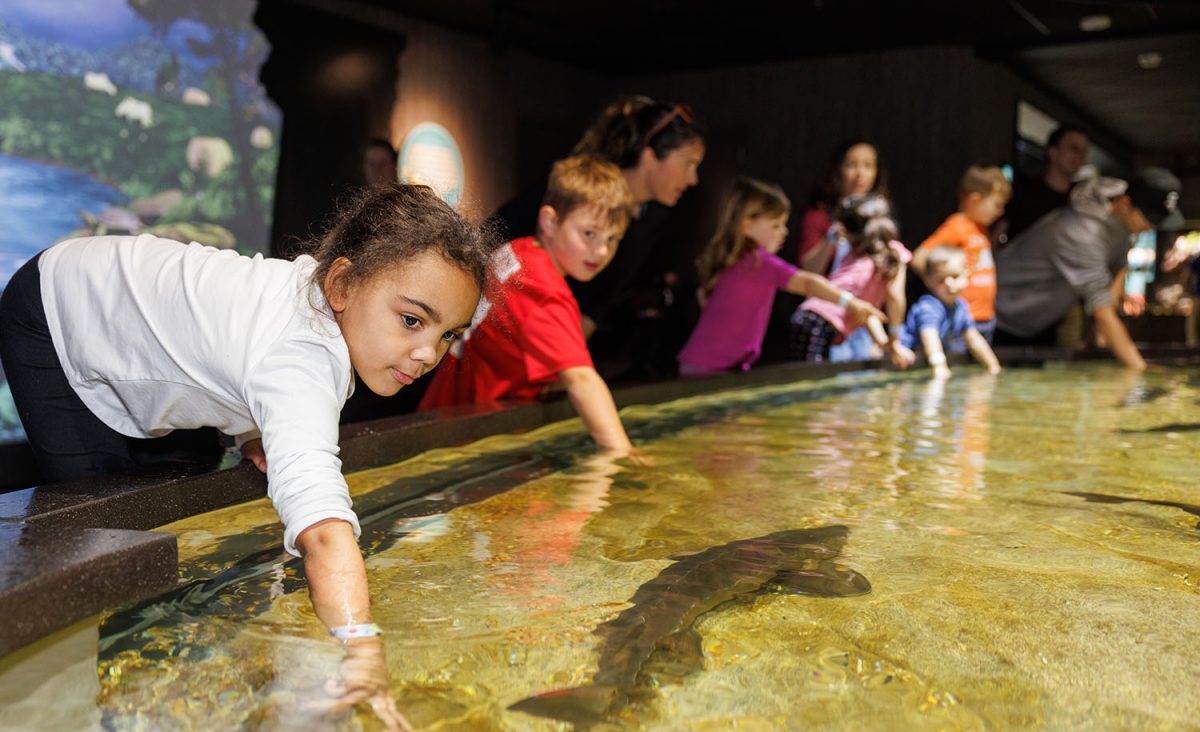Chattanooga, Tenn. (July 6, 2023) – Every year for more than two decades, the approach of summer has coincided with the arrival of hundreds, sometimes thousands, of juvenile Lake Sturgeon to the Tennessee Aquarium Conservation Institute.
Last week, biologists at the Aquarium’s freshwater field station welcomed 2,500 of these wriggling, two-inch babies into their care. As with all cohorts of sturgeon to come to the Institute, these fish eventually will be reintroduced to the Tennessee River after a summer spent growing to a releasable size of six inches on a steady diet of bloodworms and brine shrimp.
These tiny fish each hold tremendous promise as river-giants-in-the-making. Adult Lake Sturgeon can reach lengths of up to eight feet and have the potential to live for up to 150 years.
“They start out really small, so it’s shocking to think how big they can get,” says Reintroduction Biologist Sarah Kate Bailey. “The first year of life is when they grow the quickest.
“They grow so fast while we have them here. You’ll go home for the day, come in the next morning, and they look like they’ve grown overnight.”
This year marks the 25th anniversary of the Lake Sturgeon Working Group, a collaborative partnership between government and non-profit organizations with a shared desire to bring the species back to Tennessee.
Just a few decades ago, the Tennessee River was a decidedly unfriendly place for Lake Sturgeon.

A guest touches an adult Lake Sturgeon in the Tennessee Aquarium's Ridges to Rivers gallery. Online visitors can check in on this exhibit via an always-live webcam at https://tnaqua.org/live/lake-sturgeon-cam/
In the early 1970s, the combination of damming, poor water quality and overfishing led to the local extinction (extirpation) of this river giant from Tennessee waterways.
By the 1990s, however, the pendulum had reversed course, and conditions in the river were much better.
Broad protections made possible by the Clean Water Act of 1972 improved water quality across many American waterways. Additionally, reservoir release improvements of the waterway by the Tennessee Valley Authority restored water quality in stretches of the Tennessee River important for Lake Sturgeon habitat. Finally, fisheries management from the Tennessee Wildlife Resources Agency offered new protection to the species.
With the stage prepared for their return, biologists saw an opportunity to restore Lake Sturgeon to the waters it once called home. At the time of its creation, however, the Aquarium and other founding members of the Lake Sturgeon Working Group knew that goal was a long way off.
“Because of the unique life history of Lake Sturgeon, meaning that they can live a long time and don’t begin reproducing until they are anywhere from 17-25, we knew this would be a long-term project,” says Dr. Anna George, the Aquarium’s vice president of conservation science and education. “It wasn’t ever realistic to think we could release sturgeon for just a couple of years and see the population recover.
“But all of the partners knew that, if we committed to this project for a long time, we could be part of restoring this really incredible species back to Tennessee.”
To date, members of the Lake Sturgeon Working Group have reintroduced more than a third of a million sturgeon to the Tennessee and Cumberland rivers. These fish are the offspring of wild-spawning sturgeon in Wisconsin’s Wolf River. Unlike Tennessee, where the Lake Sturgeon is listed as state endangered, more of the northern populations such as those in the Wolf River are considered stable.

Eggs collected and fertilized from fish in Wisconsin are sent to the U.S. Fish and Wildlife Service’s Warm Springs National Fish Hatchery in Warm Springs, Georgia. Once hatched, the baby fish are transported to facilities such as the Tennessee Aquarium Conservation Institute’s freshwater field station to be cared for until ready for reintroduction.
The marathon effort to bring sturgeon back to the Volunteer State finds its roots in one of the Lake Sturgeon’s biological superlatives. The species’ potential for incredible longevity comes with a longer time to reach sexual maturity. Females achieve this milestone, at the earliest, by age 20.
Consequently, even 23 years into this project, only the first year classes of sturgeon of the hundreds of thousands to be reintroduced have reached the age when they could begin reproducing on their own.
When that does, happen, however, the celebrations will be immense, says Aquatic Conservation Biologist Dr. Bernie Kuhajda.
“Any signs of natural spawning Lake Sturgeon would be especially welcome,” he says. “We’re all excited at that prospect.”

Young guests touch adult Lake Sturgeon in the Tennessee Aquarium's RIdges to Rivers gallery.
When that does, happen, however, the celebrations will be immense, says Aquatic Conservation Biologist Dr. Bernie Kuhajda.
“Any signs of natural spawning Lake Sturgeon would be especially welcome,” he says. “We’re all excited at that prospect.”
To learn more about Lake Sturgeon, visit https://tnaqua.org/animal/lake-sturgeon/
To check in on Lake Sturgeon at the Aquarium, hop onto an always-live video feed of the Sturgeon Bend touch experience in the newly opened Ridges to Rivers gallery at https://tnaqua.org/live/lake-sturgeon-cam/
Partners in the Southeastern Lake Sturgeon Working Group include:
- Tennessee Aquarium
- Tennessee Valley Authority
- Tennessee Wildlife Resources Agency
- U.S. Fish and Wildlife Service
- U.S. Geological Survey
- Tennessee Technological University
- University of Tennessee
- Conservation Fisheries Inc.
- Kentucky Department of Fish & Wildlife Resources
- Georgia Department of Natural Resources
- North Carolina Wildlife Resources Commission
- Wisconsin Department of Natural Resources
- World Wildlife Fund